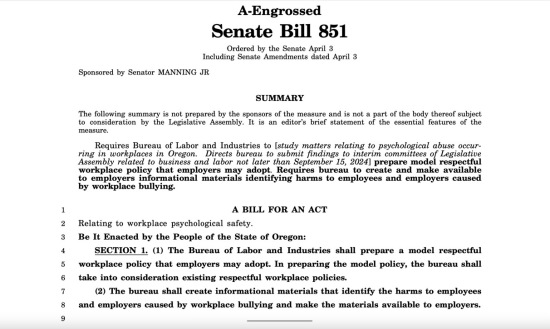
(Flying monkey image courtesy of Clker.com)
Workplace bullying and mobbing. Yes, generically speaking, it’s about the experience and conditions of work. But at a human level, it’s often about apprehension, fear, and even terror. And for someone experiencing full-on work abuse or recovering from it, it’s very likely driven by the dynamics of psychological trauma.
A new lexicon
Andrea Adams, the British journalist who popularized the term workplace bullying during in the late 1980s, knew well about how terrifying, cruel, and malicious this form of abuse could be. In a 1994 speech before a British trade union (link here), she observed that, in the course of her investigations:
…people have described this experience as everything from psychological terrorisation, to emotional rape, to entering a war zone. Their accounts are all so similar that l can now predict when somebody contacts me, what they are actually going to say and the way in which they identify bullying, and their physical and emotional responses to it.
Adams’s journalistic explorations would be echoed by academic research. I frequently invoke an important study by communications professors Sarah Tracy, Pamela Lutgen-Sandvik, and Jess Alberts, “Nightmares, Demons, and Slaves: Exploring the Painful Metaphors of Workplace Bullying,” Management Communication Quarterly (2006) (link here), which found that bullying targets’ narratives of their experiences “were saturated with metaphors of beating, physical abuse, and death.”
Once a targeted individual learns about workplace bullying and mobbing and certain terms used to describe its variations, a familiar vocabulary may come into play: These terms are often woven into narratives that describe their experiences in very emotional terms. They include, among others:
Gaslighting — In The Gaslight Effect: How to Spot and Survive the Hidden Manipulation Others Use to Control Your Life, (2018 rev. ed.), Dr. Robin Stern defines gaslighting as:
a type of emotional manipulation in which a gaslighter tries to convince you that you’re misremembering, misunderstanding, or misinterpreting your own behavior or motivations, thus creating doubt in your mind that leaves you vulnerable and confused. Gaslighters might be men or women, spouses or lovers, bosses or colleagues, parents or siblings, but what they all have in common is their ability to make you question your own perceptions of reality.
I have written frequently here about gaslighting, including its use as a work abuse tactic (e.g., links here and here).
DARVO — As explained by Dr. Jennifer Freyd (President, Center for Institutional Courage; U. Oregon, emerit):
DARVO stands for “Deny, Attack, and Reverse Victim and Offender.” The perpetrator or offender may Deny the behavior, Attack the individual doing the confronting, and Reverse the roles of Victim and Offender such that the perpetrator assumes the victim role and turns the true victim — or the whistle blower — into an alleged offender. This occurs, for instance, when an actually guilty perpetrator assumes the role of “falsely accused” and attacks the accuser’s credibility and blames the accuser of being the perpetrator of a false accusation.
I have written about DARVO in connection with aggressors claiming victim status in workplace bullying situations (link here).
Flying monkeys — As explained for PsychCentral by Christine Hammond (link here):
When the narcissist wants to evoke some punishment on a target they dispatch their henchmen (aka flying monkeys) to do their bidding. Unfortunately, this can and often does include abusive behavior such as guilt-tripping, twisting the truth, gaslighting, assaults, threats, and violence.
She further details the roots of the term:
The term was coined from the movie The Wizard of Oz in which the Wicked Witch dispatches monkeys to fly and get Dorothy and her dog. The monkeys obey her command, doing her dirty work for her, taunting and terrorizing Dorothy as she tries in vain to get back home. And so it is with narcissists and their flying monkeys.
Thus, we are most likely to hear references to flying monkeys in the workplace bullying and mobbing context when a boss directs their minions to harass and abuse a designated target. I have dubbed this behavior “puppet master bullying” (link here), but the choice of terminology is less significant than understanding the underlying behavior itself.
The neuroscience of bullying and mobbing at work
Why do so many targets of severe, continuous bullying and mobbing at work invoke emotional terms and descriptions in characterizing their experiences, rather than provide ordered narratives of their stories? For insight, I once again turn to Dr. Bessel van der Kolk‘s indispensable The Body Keeps the Score: Brain, Mind, and Body in the Healing of Trauma (2014).
Dr. van der Kolk summons neuroscience research on brain functioning to explain what happens to some people when experiencing or reliving a traumatic event. In essence, the side of the brain associated with emotions, intuition, creativity, and imagination — the so-called right side — becomes fully activated. During brain scans when individuals are asked to recount traumatic events, it lights up like the proverbial Christmas tree. By contrast, the side of the brain associated with logic, raw facts, linear thinking, and sequencing — the s0-called left side — shuts down. During these brain scans, it goes dark.
With this in mind, it is utterly understandable why targets of bullying and mobbing at work often describe their experiences in emotion-laden terms. Many will experience difficulty reducing these experiences to the kinds of sequential narratives that HR personnel, union shop stewards, or employment lawyers typically seek in trying to grasp what happened and whether an individual can provide facts to support their claims. This can further undermine a target’s credibility and make them appear unstable and unreliable, when in reality it is often the trauma talking.









